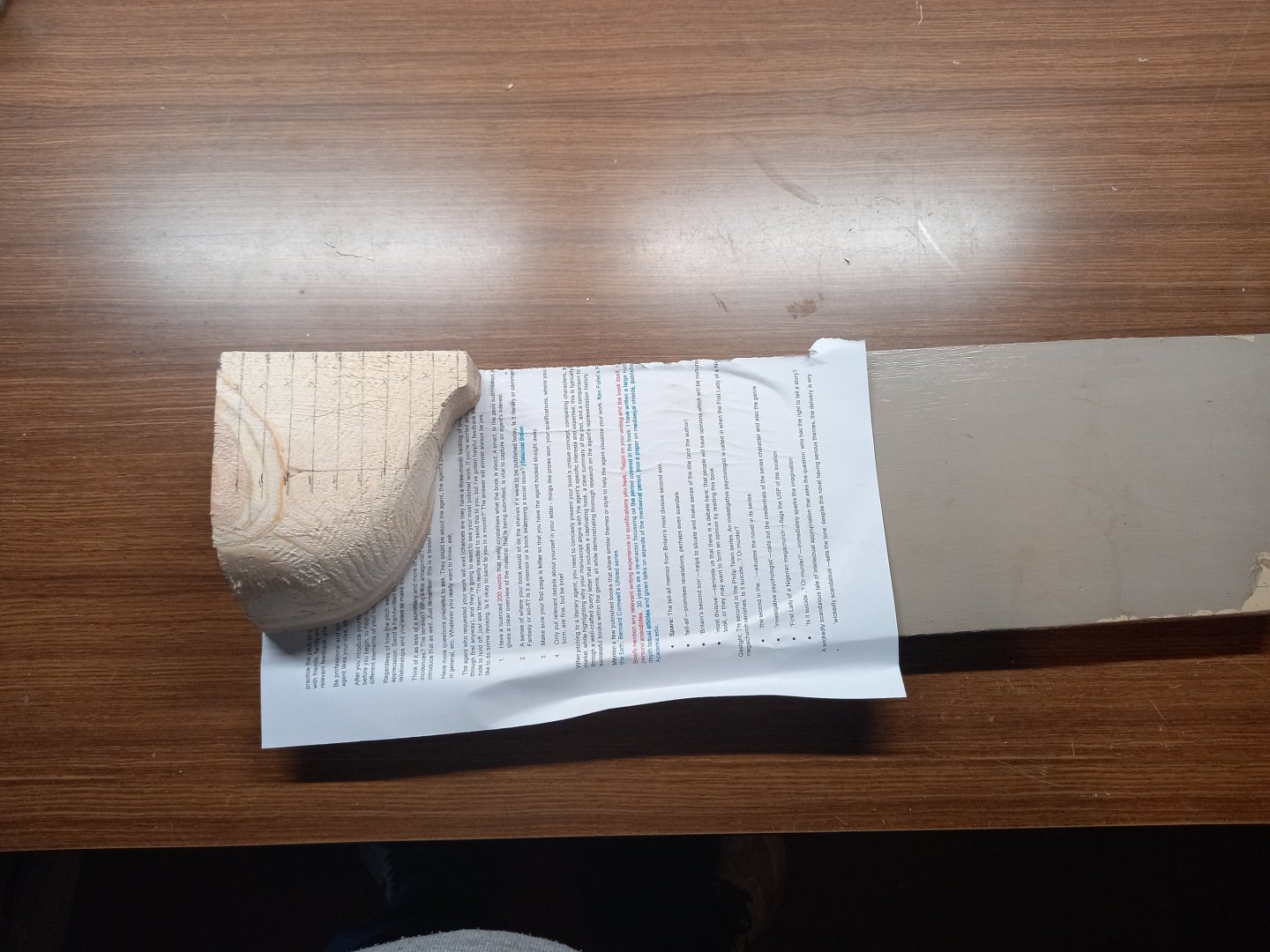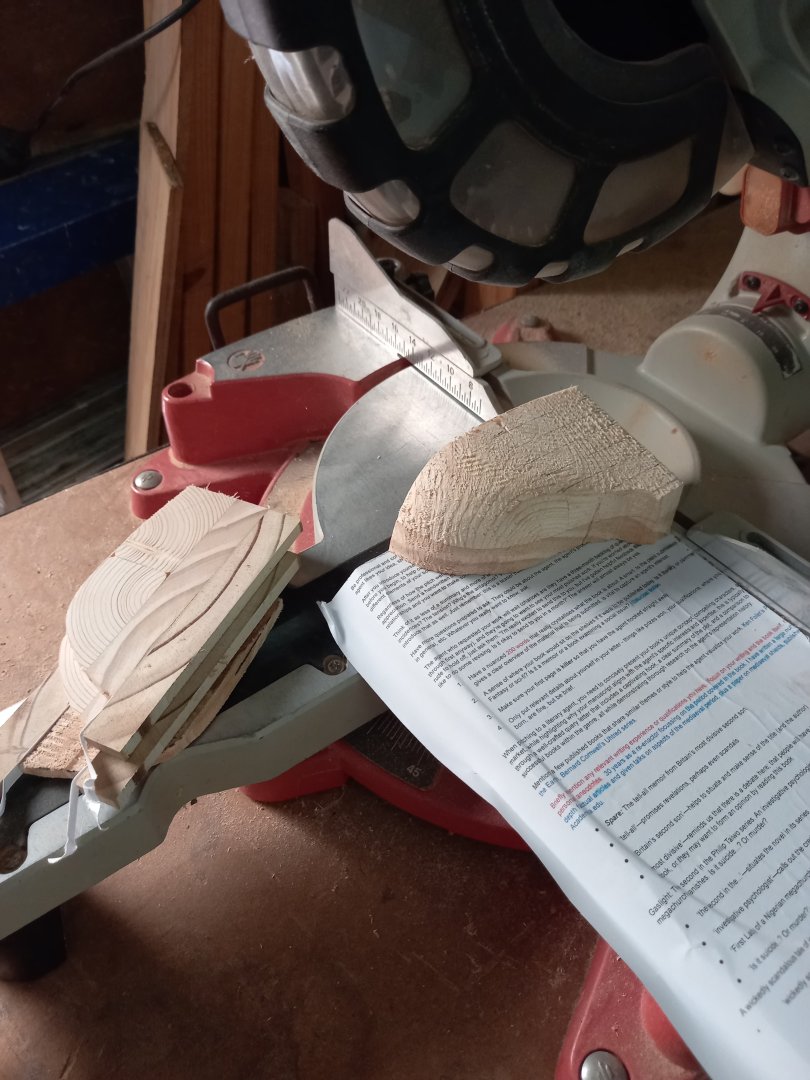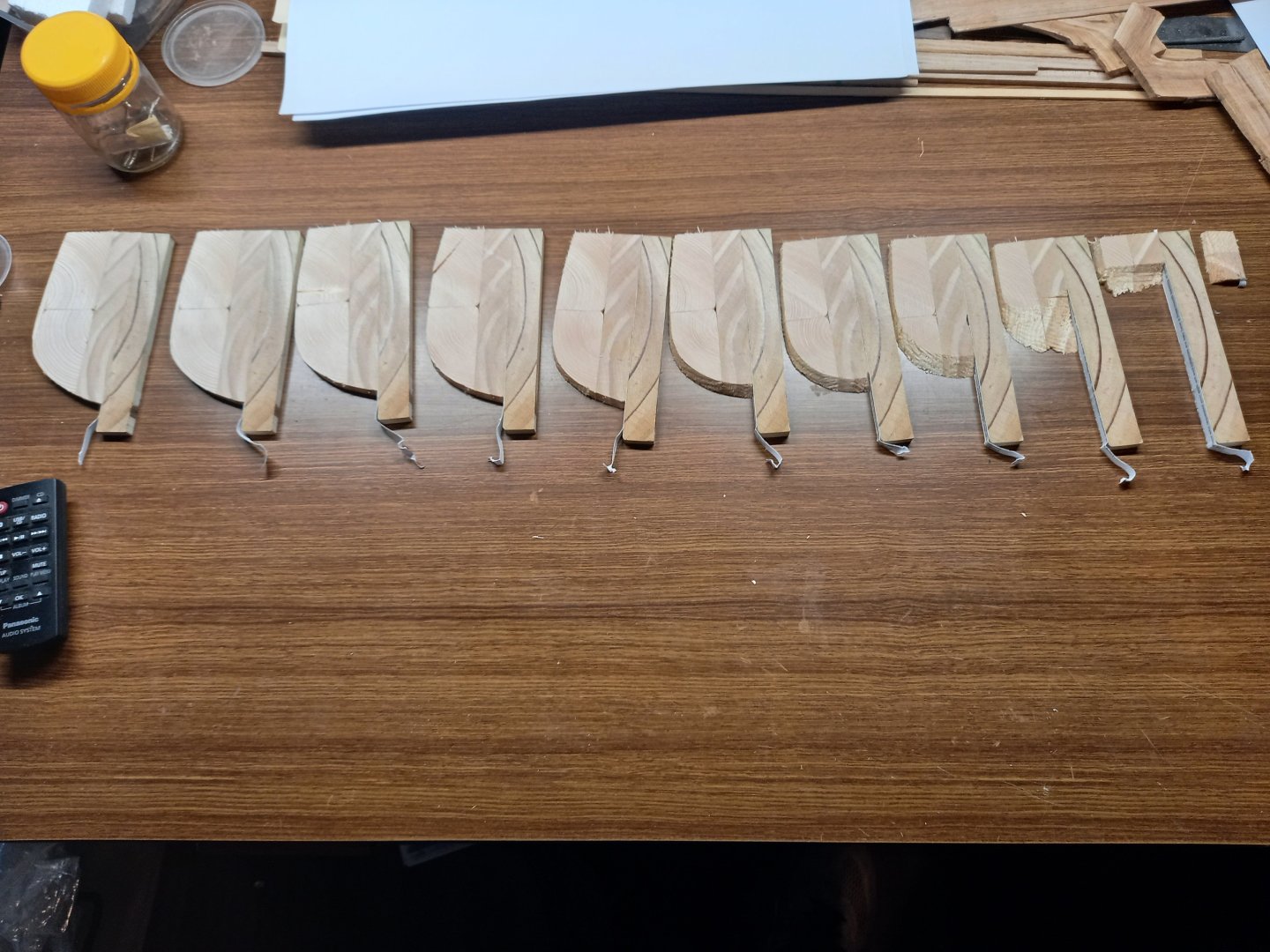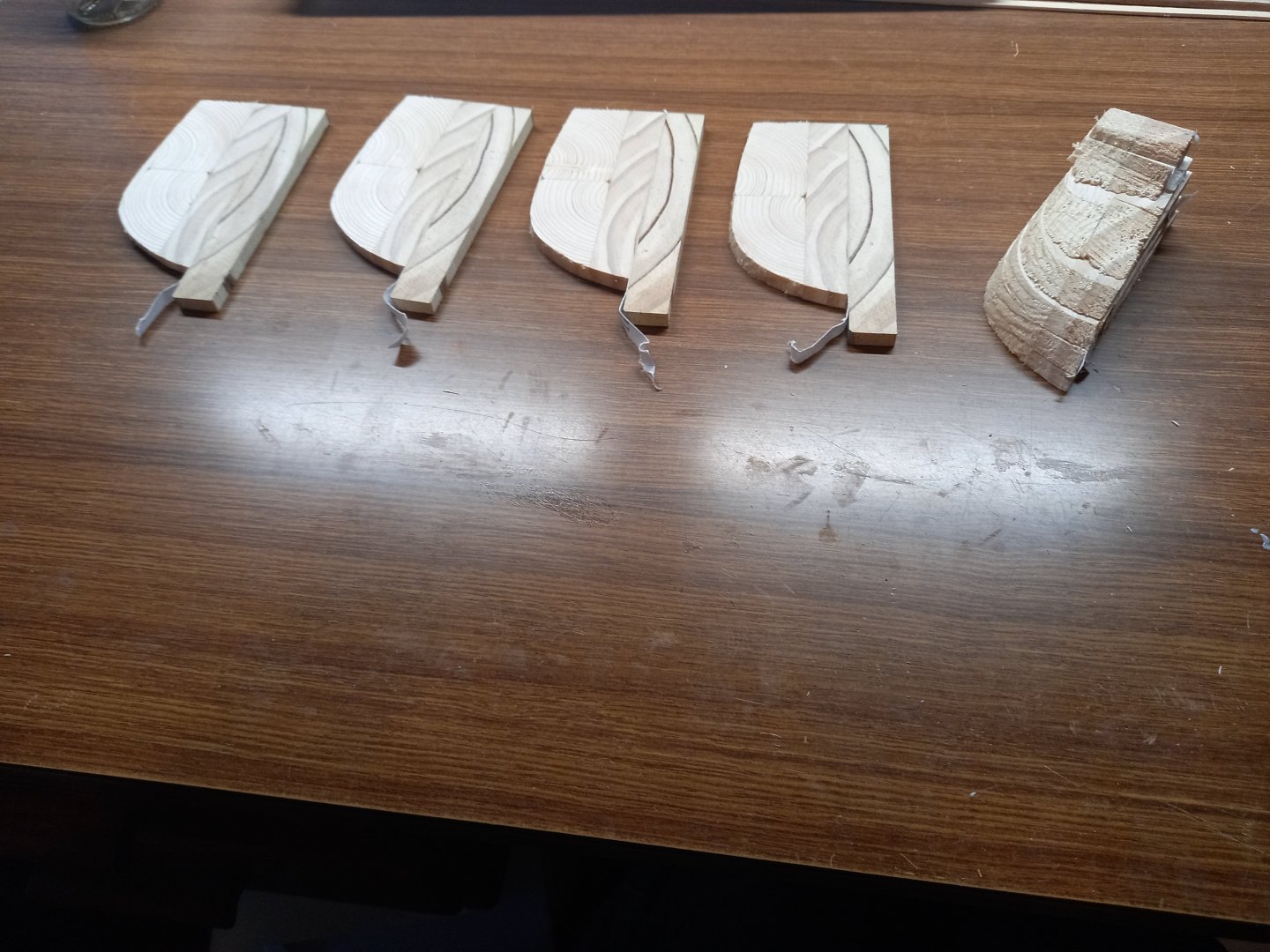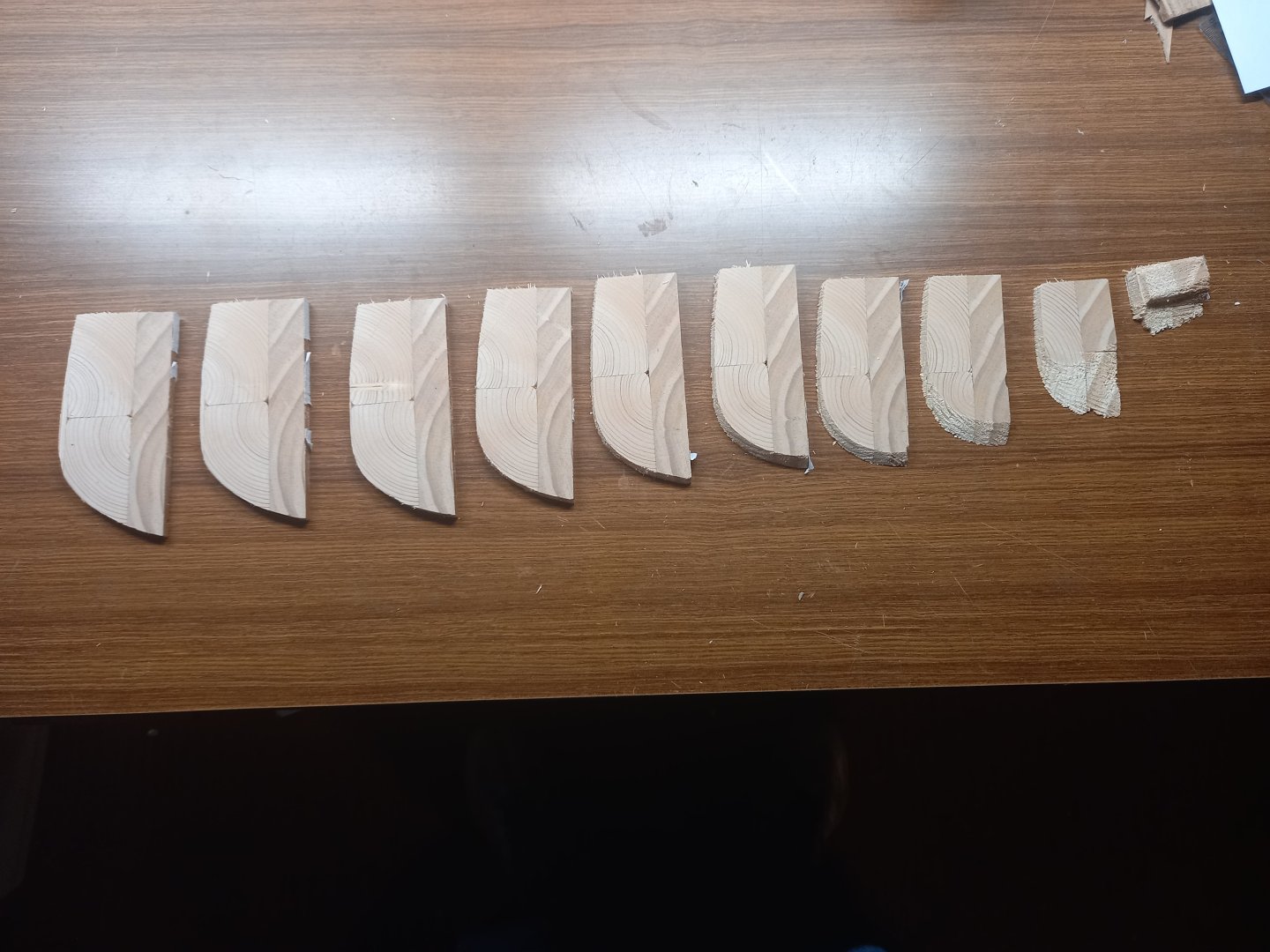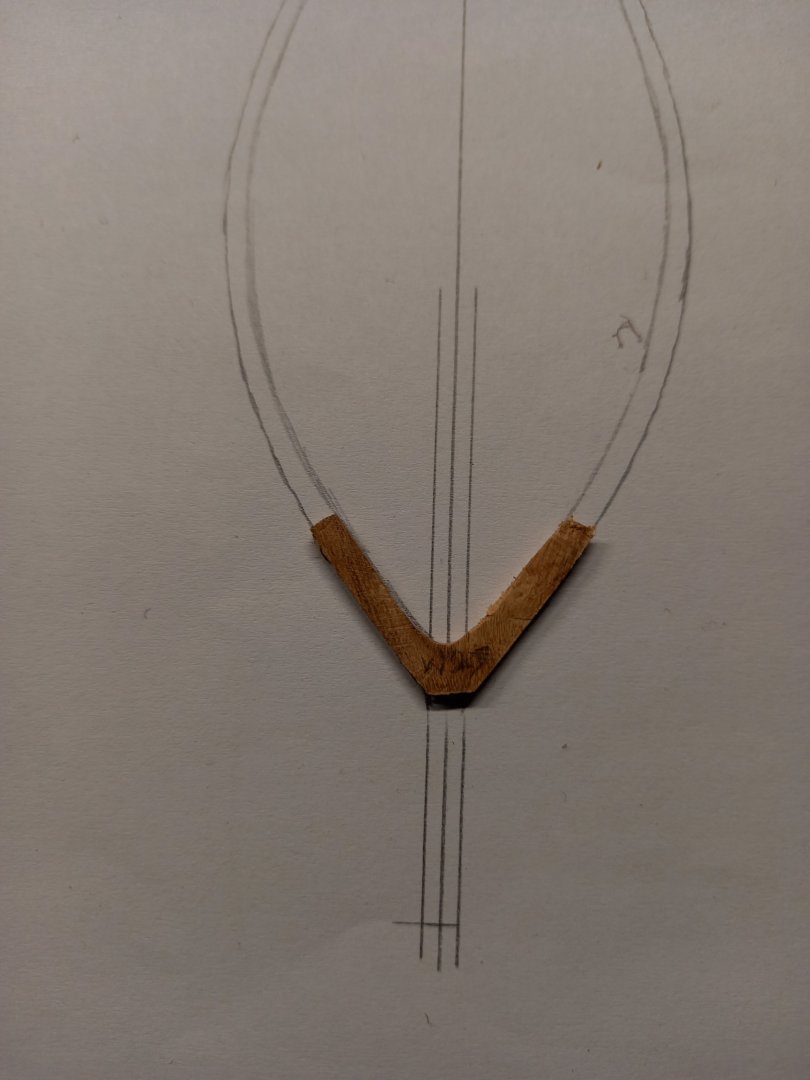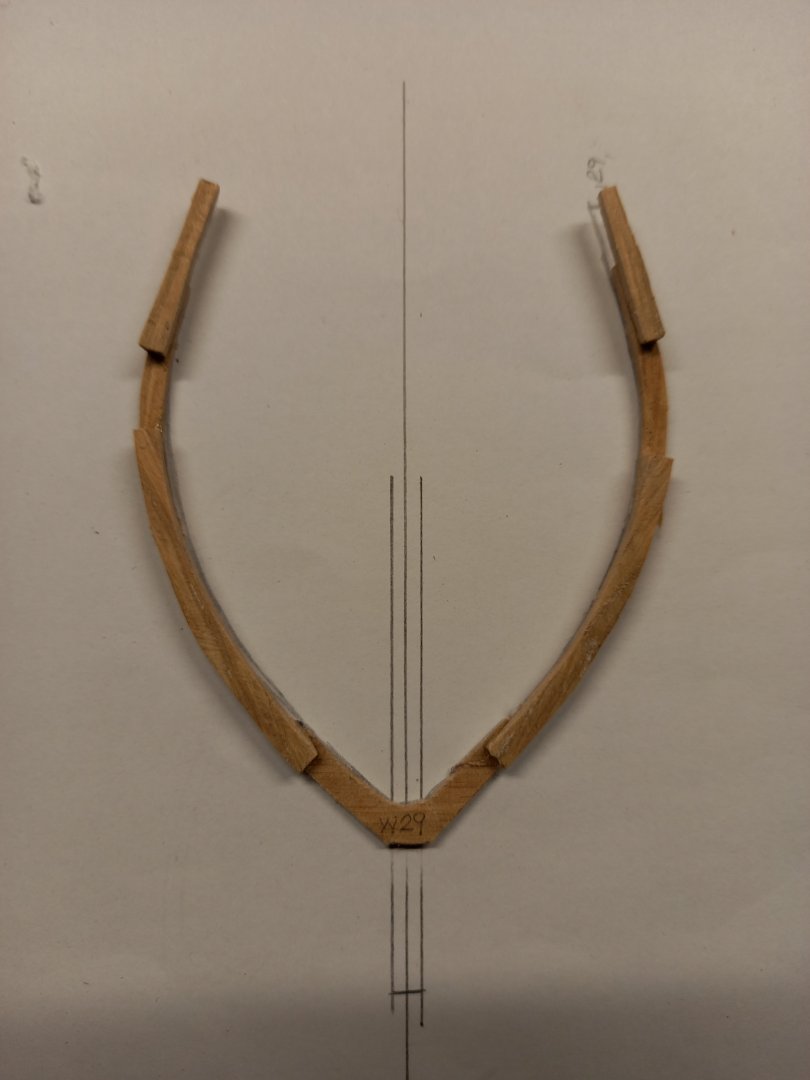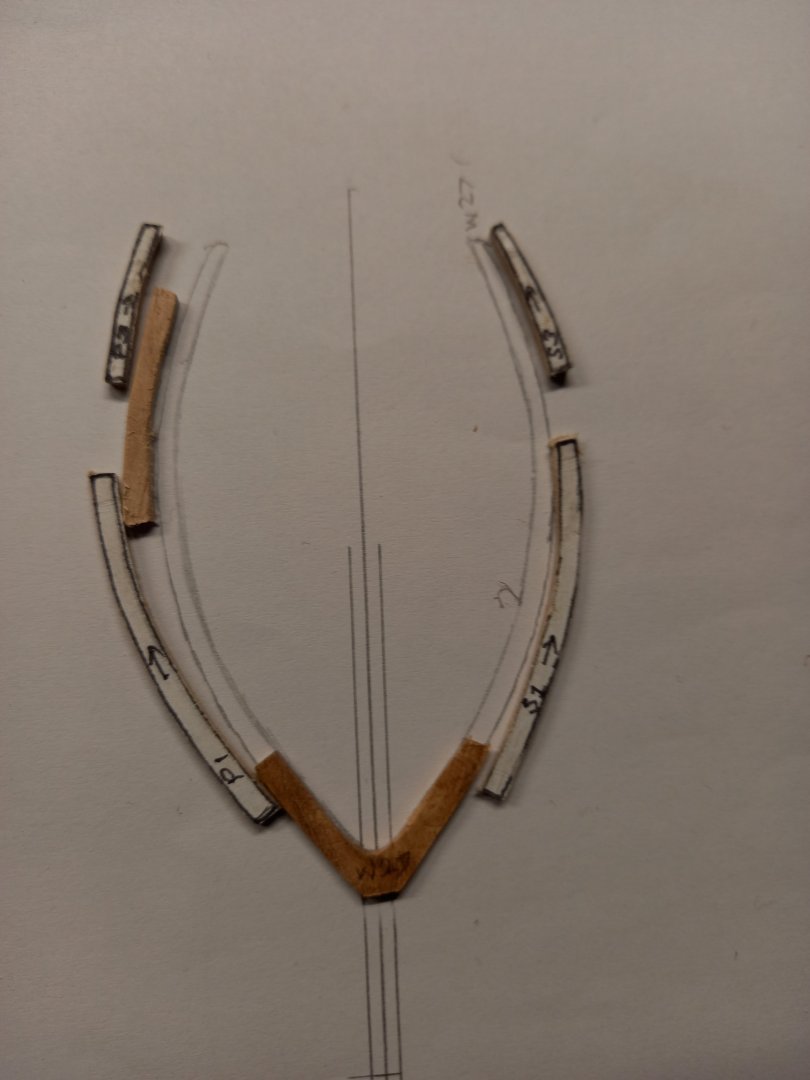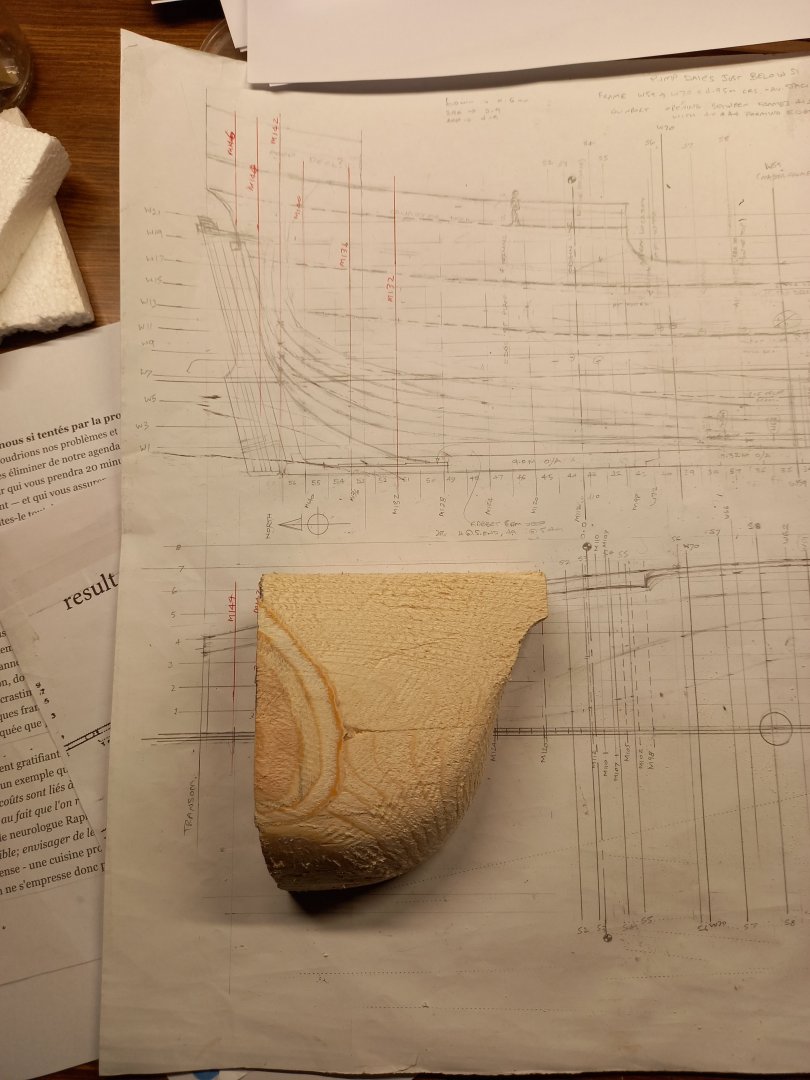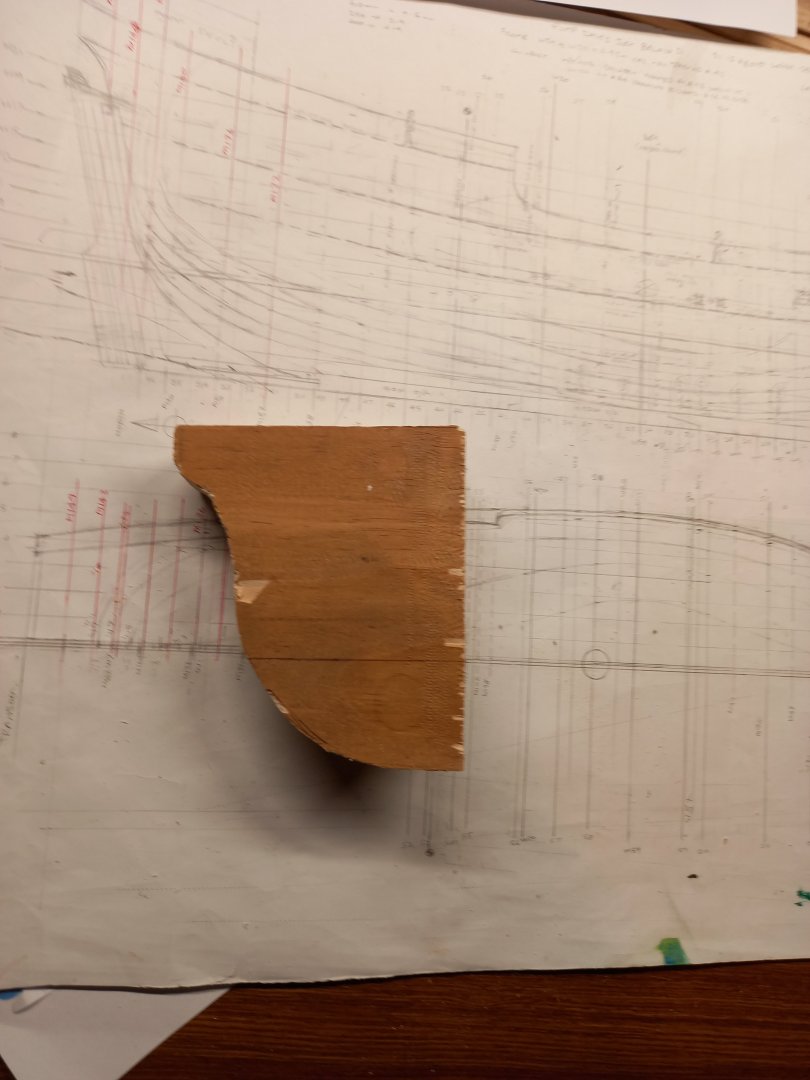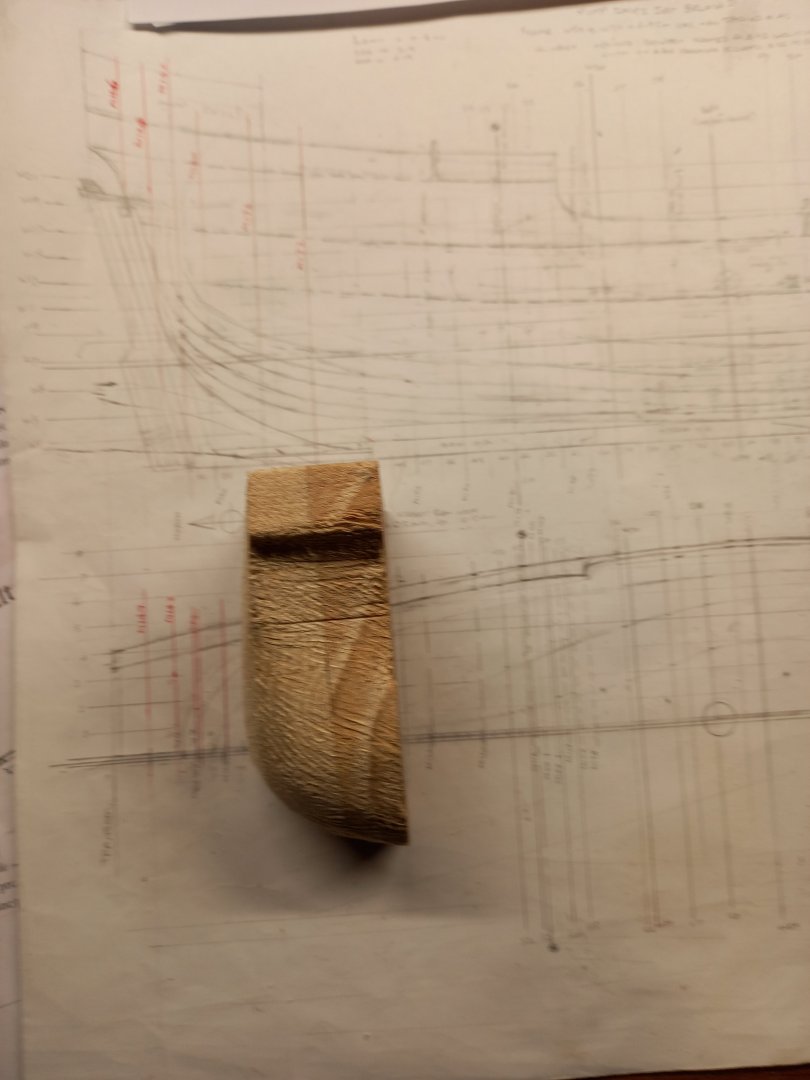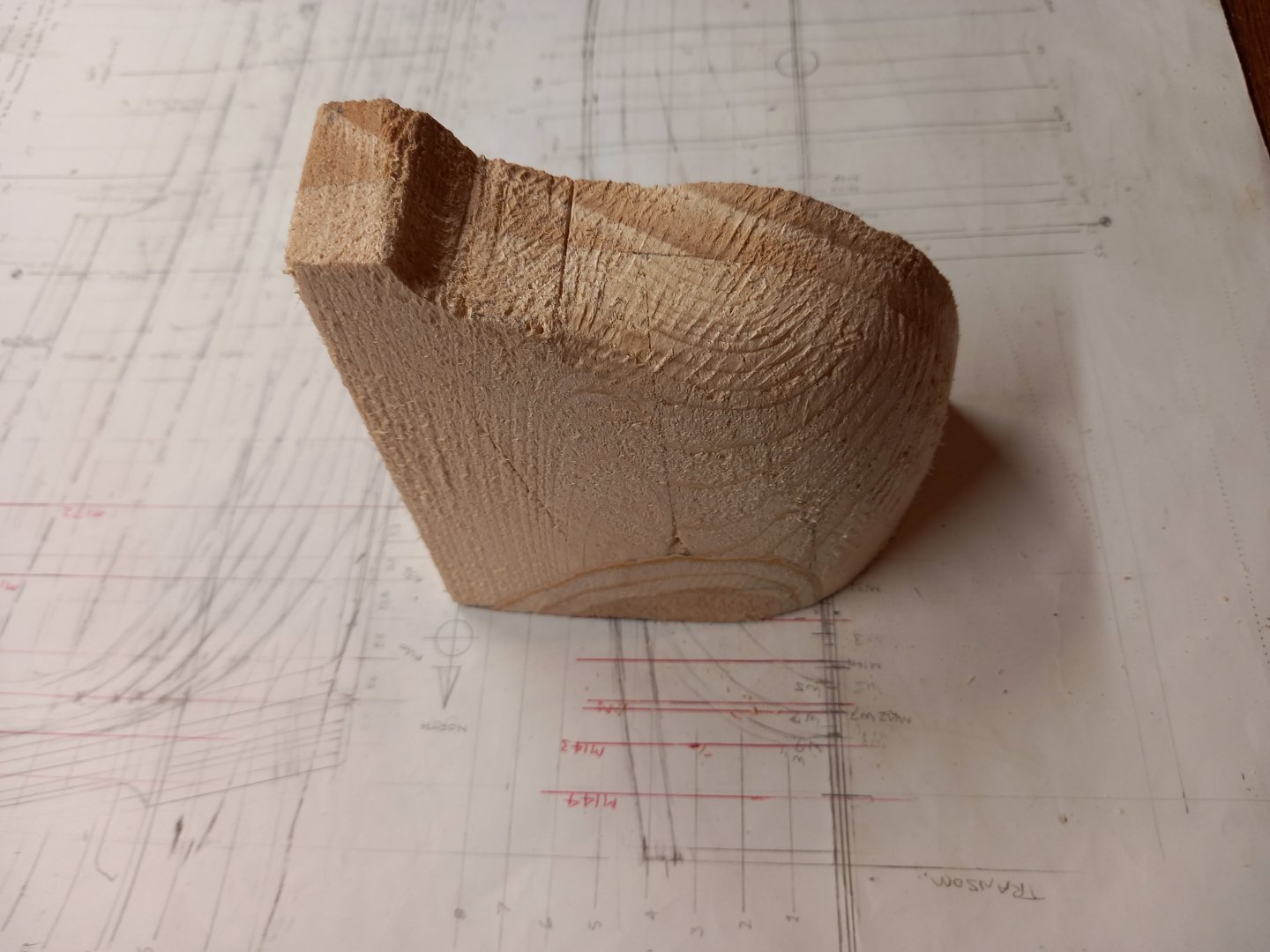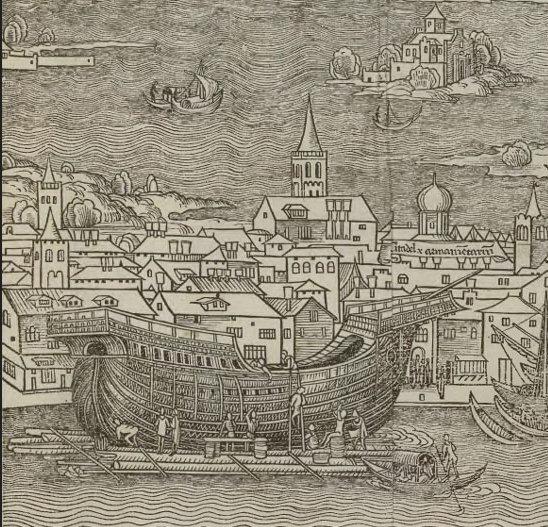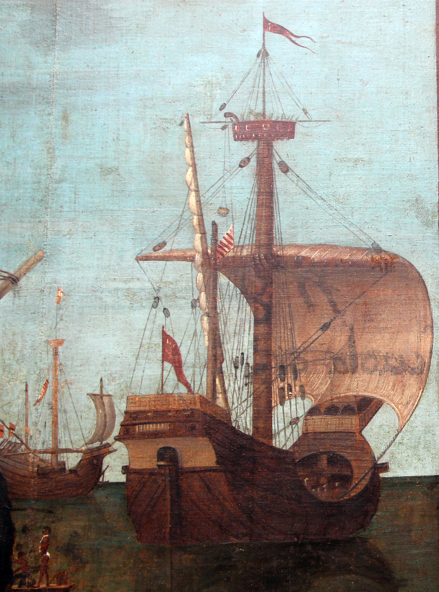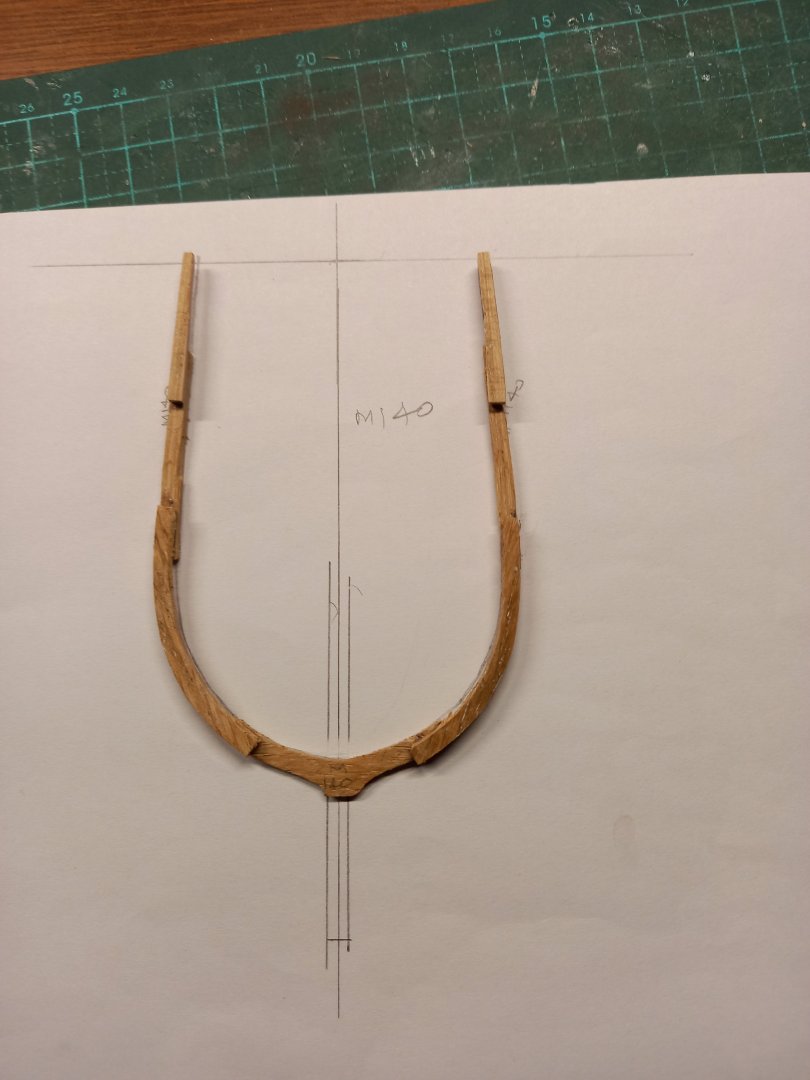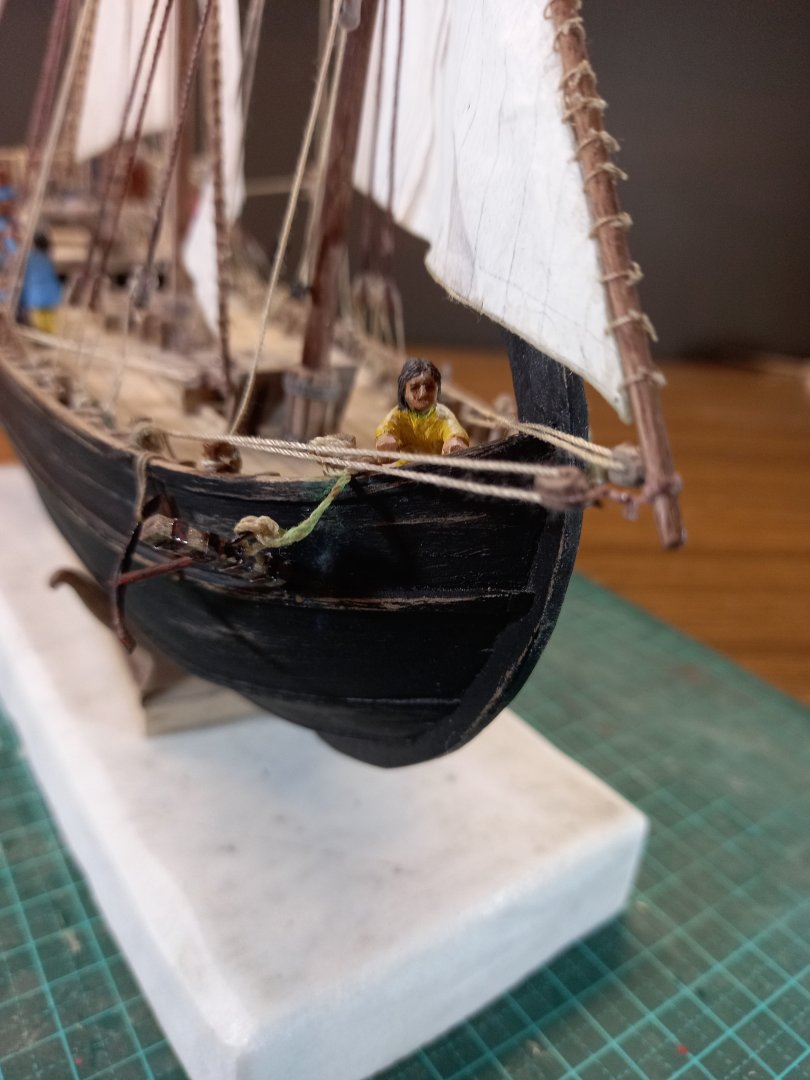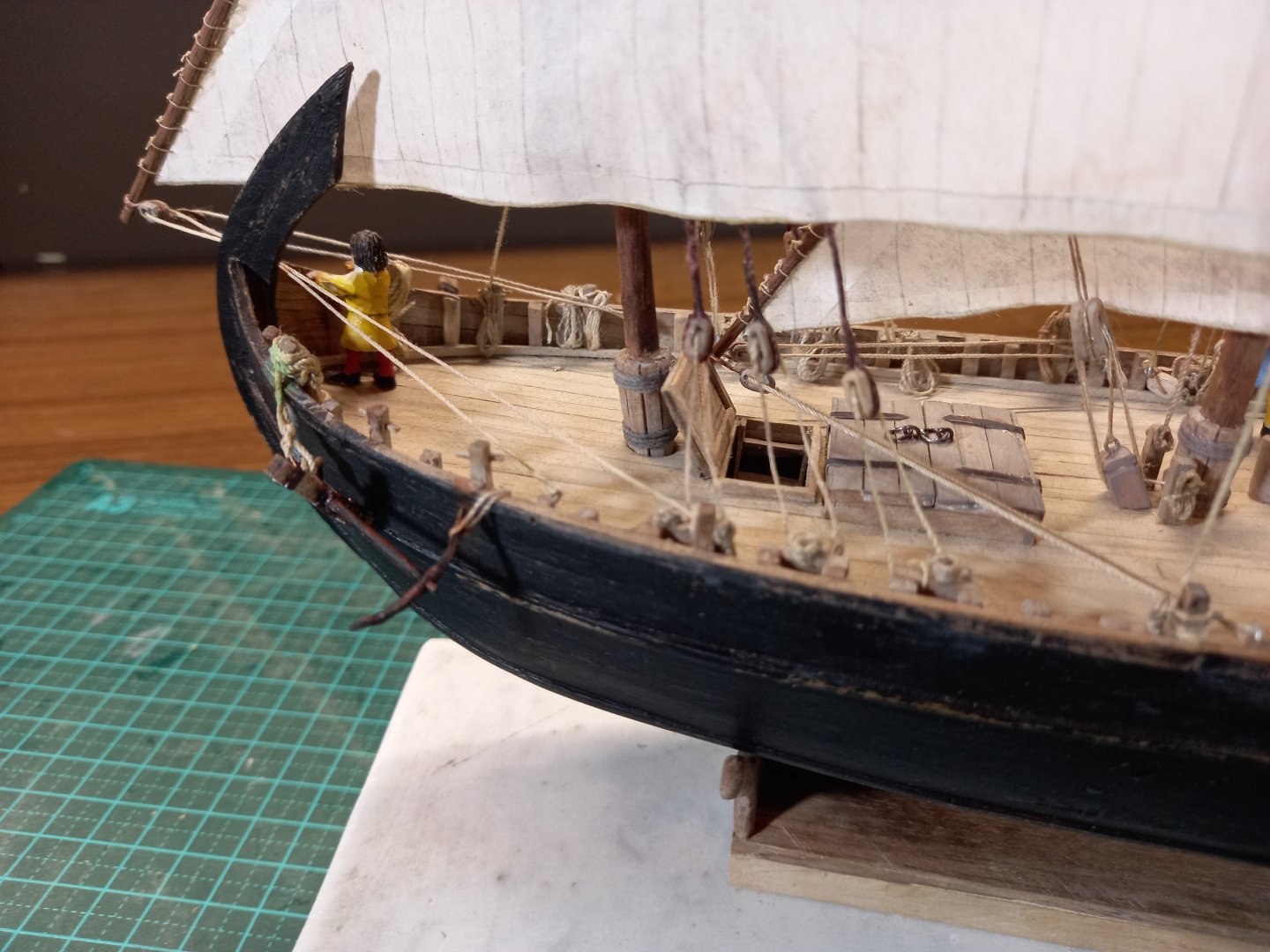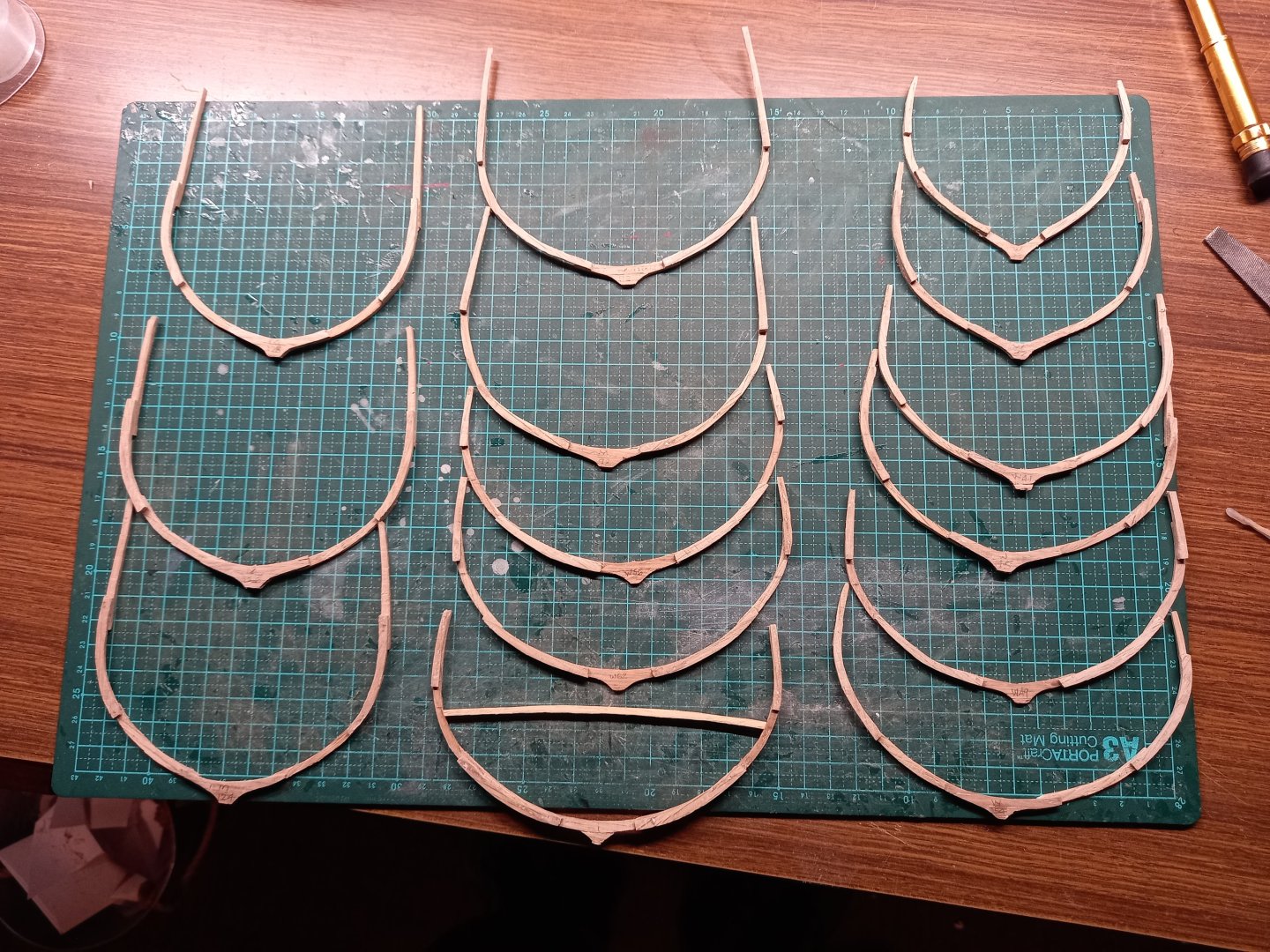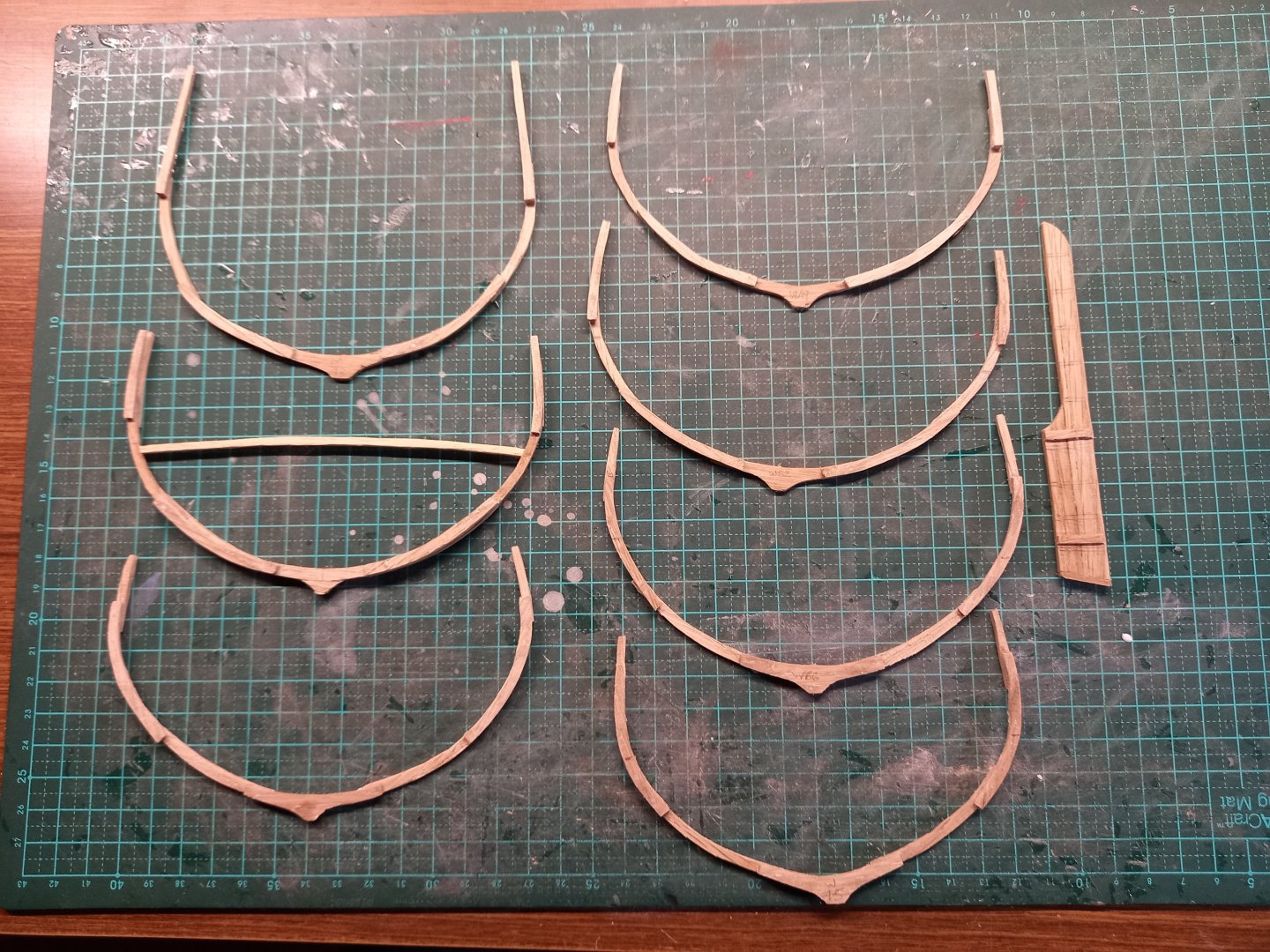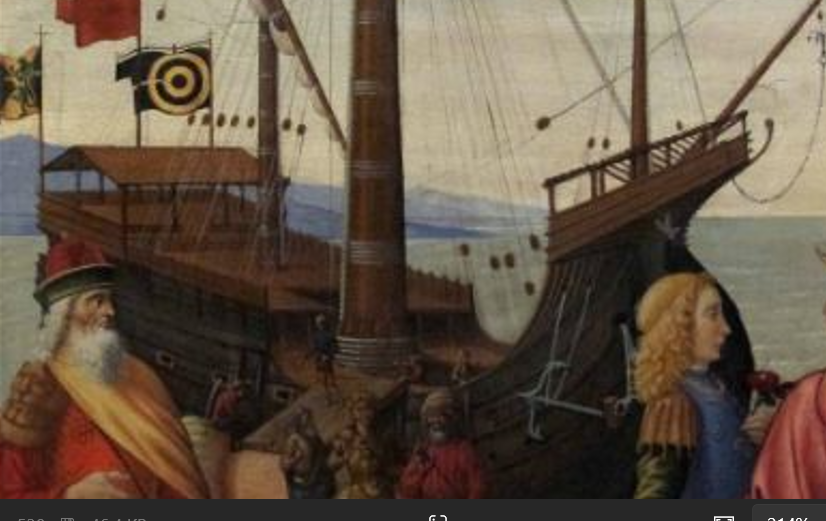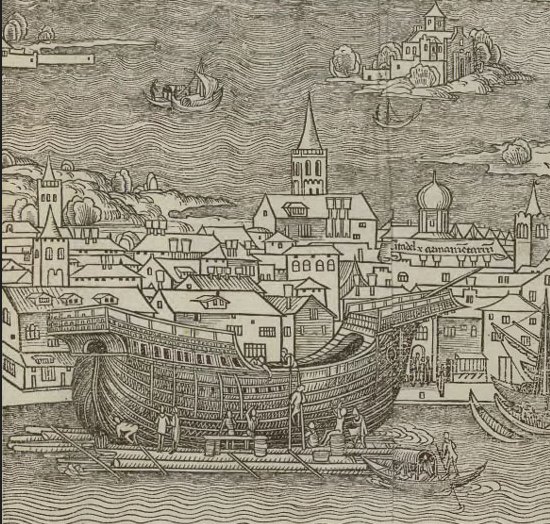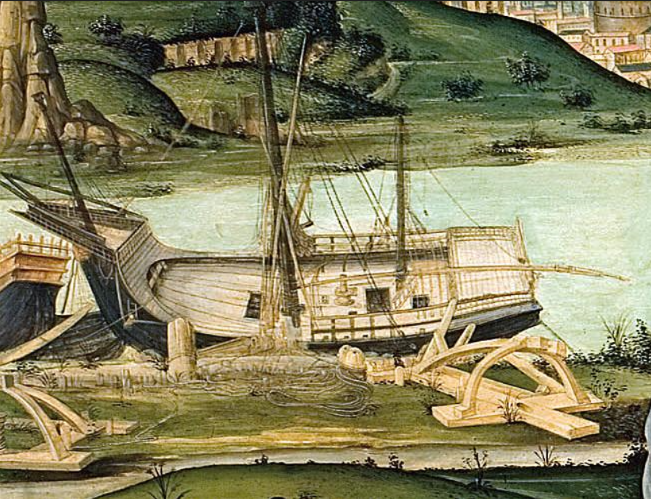-
Posts
7,987 -
Joined
-
Last visited
Content Type
Profiles
Forums
Gallery
Events
Everything posted by Louie da fly
-
I agree about reducing the height of the upper part of the forecastle. It looks better that way. And yes, red, white and yellow stripes. The colours on the Anthony Roll are a bit difficult to interpret, but certainly not green and white as shown in the modern picture. Guns and carriages look great (Henry the Staffy's a real gem!) and the ladders are spot-on. Nice work (as usual!), Patrick. Steven
-
Thanks for all the likes, and thanks to Druxey for the comment. So here's the result so far. I glued the shaped form to a longer wooden plank, so I could feed it through the drop-saw without cutting my fingers off. I glued a sheet of paper between the form and the plank so I could break them apart after they'd been sawn into slices. And here they are in the saw - part-way through the process. And all cut. About half have been separated from the remains of the plank. (One of them had a corner split off, so I glued it back again and this photo shows them at the point where I'm waiting for the glue to dry). And here they all are, ready to be used as templates for the new frames. Steven
-
I've been working on the other frames. Here's one from the bow - the French refer to the V-shaped piece at the bottom, charmingly, as a fourcat. But I came to the conclusion that the shapes I'd worked out for the frames of the aftercastle and some for the bow were based on a wrong premise - I hadn't taken into account the evidence of contemporary pictures and had made them much too narrow, and quite a few of them will have to be either tossed or dramatically altered. The first pic below is the frame as made; the second is how wide it ought to be. I'm hoping I can at least salvage some of the futtocks, but I'm pretty sure the floor timbers will have to be ditched. I eventually got sick of trying to figure out the frame shapes on paper from the lines I'd drawn up - every time I worked it out it was different. So I went a different way. Based on the sterns of carracks from contemporary representations from near the Lomellina's time, I made a solid half-hull, going aft from the last frame I was happy with Took very little time - a couple hours with a hand-saw and a rasp, once I'd decided to do it. Next I'll be cutting this solid shape into slivers at 10mm ( a bit under half an inch) intervals - equivalent to every second frame - along the length of the keel, to get reliable shapes for the frames. Wish me luck! Steven
-
I've done both. My earlier models were 'pristine', but I have been slowly teaching myself to weather my wooden models. Some people are masters of weathering - have a look at RGL's wonderful (plastic) warships - his Dreadnought, Heian Maru etc. And somewhere on the forum there's a Russian battleship of his from the Battle of Tsushima which I can't find (unfortunately) - it's amazing! Here's a bit of my own weathering - a 12th century Mediterranean merchant ship that doesn't get a lot of TLC - the owners are more interested in immediate profits than maintenance. And yes, I have enough figures on board for a full crew. I carved them from pear wood - scale 1:75 . I've perhaps been a bit cautious about applying the weathering - better than too much. Still learning, and learning how to shade the figures so they don't look like they're model railway figures straight out of the box. Steven
-
Better choice, in my opinion. Santa Anna is VERY complicated. Building the Santa Maria will develop your skills at a much gentler gradient, but they will be skills you can then use on more ambitious models. And as I mentioned before, don't hesitate to ask questions. BTW, Santa Maria is a type of vessel known as a carrack, which I just happen to be very fond of - in fact I'm scratch building one myself at the moment. So if you do have questions I may be able to help. And check out Woodrat's wonderful Venetian Carrack or Cocha build as well. Steven
-
Ah! Santa Maria! Totally different model. Much less difficult. But now I'm confused - your Feb 22 post says Santa Anna! Steven
-
Hullo again, John. Though I've visited towns all around it - Dubbo, Mudgee, Newcastle, Tamworth; I've never been to Scone. I've looked at some photos of the town and it looks nice. Some good heritage buildings there. You're taking on quite a challenge with the Santa Anna. A very steep learning curve and a very large and complex model. You might find it too much of a challenge, though I have seen first timers on this forum complete things of similar complexity. If you do hit a brick wall with it, though, you might want to put it on hold and undertake a less demanding model as a transition piece. It's a huge jump from your existing model to the proposed one. But if you do have questions or need help on the Santa Anna, don't hesitate to ask. The people here are very knowledgeable and helpful. Best wishes, Steven
-
Same here. That's why my signature says what it does . . .
-
Hi Fiurar and welcome to MSW. That's quite an ambitious project you've taken on. There are quite a few build logs for the same model on MSW - I just did a search for them and came up with this - https://modelshipworld.com/search/?q=corel victory&quick=1 You might find it helpful to have a look at what others have done building it and any traps or problems that you can be forewarned about - and how other people solved them. I'd recommend you start a build log for your model - it's a great opportunity to get help and feedback and get your questions answered. The MSW members are very friendly and helpful. Instructions on how to begin your build log are here: https://modelshipworld.com/topic/24705-before-you-post-your-build-log-please-read-this-starting-and-naming-your-build-log/ Have fun with it! Steven
-
Let me get this straight. This is your first model? Not bad for a beginner, mate. For the next one, can I suggest you start a build log? Great way to get feedback and advice. The people here are very friendly and helpful, and we have some of the demi-gods of ship modelling as members. As an old fart myself, I want to be them when I grow up. Instructions for starting a build log are here: BTW, where in Oz are you? As you can see, I'm in sunny Ballaarat, jewel of the south. Steven
-
On the other hand several of my ship models have had narrow escapes from being thrown against the wall in a fit of anger . . . Welcome to MSW from sunny Ballarat, Australia, mate! In deciding what model to start on, I'd recommend you read this: And I'd also recommend you start a build log when you do get into your model. If like most people you're starting out with a kit (rather than scratch-build) instructions are at Have fun with it. Steven
-

New here, checking the place out
Louie da fly replied to jbassett's topic in New member Introductions
Hi John, and welcome to MSW. You've made a good start. As you improve your skills you'll be able to take on more and more advanced builds, but don't be upset if you continue making the odd mistake. Everybody does - it's one way to learn. Preferably to learn so you don't make the same mistake again (though of course even that's not a given). The main difference is that the more experienced modellers make much more interesting mistakes. And enjoy the journey. It's something between a whole new exciting adventure and a whole new exciting can of worms. Depends on the day . . . And I'd recommend you start a build log for your next one. A great way to get feedback and advice from people who've been there before - the people here are very helpful and friendly - and we get to see your model under construction. Always a good thing. Steven -
looking very good. I like the tackles particularly. That mesh you're using for the boarding netting - it's a shame you couldn't get something that was just net with no decoration. I was lucky to get plain mesh. Regarding the colour, keep in mind that the netting could well have been tarred and might have been black or something approaching it. The other thing is that white mesh would very likely be distracting to the eye and would hide the detail below. I'd be going for black or dark brown, myself. Does your local store have anything in those colours? Steven
-
14 frames complete. The shape of the vessel is starting to make itself known. I'm currently agonising over the cannons (yes, I know its a bit previous to be doing that at this stage, but that's me.) So 15 guns were found associated with the wreck, but only two will be behind gunports (as that appears to have been the way it was in the very early days of gunports - see earlier posts). So what happens with the other 13? Are they on big wheels so they reach over the gunwale? And then there are several guns retrieved in 1531, one of which was a large bronze perrier (meaning the balls it shot were of stone), and there were a number of swivels. Also several wrought iron guns of different types, one type very long compared with its calibre. Unless I much mistake, except for swivels, all the wrought iron guns needed to be deck-mounted because they weren't structurally strong enough to support themselves. But that would presuppose gunports unless they had big wheels. There were a number of big wheels found on board, some of 120 cm diameter, some of 148. This would mean a gunwale of somewhere between 60 and 80 cm high if they were to poke out above it. That's 2 feet to about 2 ft 7 in. Not terribly high. Sigh. I'm in a bit of a quandary. It's assumed that between 1516 when she sank and the retrieval of 1531 the citizens of Nice may well have plundered the wreck for cannons, but there's no written record of that. Swivels could be in arched openings shown to the forecastle in Carpaccio's paintings, or even in the aftercastle as shown in others. It's a matter of deciding what goes where. Though she was a merchant ship, it looks like the Lomellina was upgunned when she was hired by the King of France to transport munitions. And perhaps some (or all?) of the guns were cargo rather than armament? Oh, and they recovered two bronze arquebuses (precursor of the musket, but considerably heavier construction.) It's a problem at the moment, and any solution I come up with is going to involve a tremendous amount of speculation and guesswork. I'm trying to make it educated guesswork. Steven Steven
-
Report of 24 October 2024: "STS Leeuwin II is back on the water! After the August dismasting - and the delicate process of cutting away the destroyed masts and rigging - this is the first time the ship has moved since the accident. Today’s hour-long shakedown voyage is a crucial step in testing vital systems like steering and propulsion, as they assess the full extent of the damage before moving forward with repairs. The ultimate goal is to return Leeuwin to service, benefitting the young people of Western Australia. A small professional crew was onboard today, joined by a few dedicated volunteers to assist with line handling. A huge thanks to @jetwavemarine_ for providing a support tug, and to @svitzerau for offering a gangway after the original was destroyed in the incident. Follow @sailleeuwin for more updates! 🌊" And for a definitive and informative article from November 2024 on the future of the Leeuwin and possible replacement, see https://fremantleshippingnews.com.au/2024/11/11/what-to-do-with-sts-leeuwin-part-2-a-new-vessel/ - only one bit of criticism - Leeuwin is a Dutch name, not French. That's the most recent stuff I can find. Steven
-
Sorry, Alvb. I do understand your pain. I've experienced the same problem myself - in fact I'm currently on a very long process of translating the annual archaeological reports (about ten of them) of the Lomellina from their original French. I speak a little of the language, but not enough for fluent reading of technical maritime papers, so I'm making great use of Google Translate, plus a French-English dictionary of maritime terminology. Despite Google's many faults, it's a great help. Oh, and seven frames now complete. Unfortunately the main delay is waiting for the glue to dry between putting on one futtock and the next. Putting two on at the same time is a recipe for disaster - you generally end up with both out of alignment. Steven
-
Yes, wonderful artist though Botticelli was, I'm not sure he was au fait with the intricacies of ship design. I know of only one other painting of his that incorporates a ship, and it's identical to this one - obviously working off the same sketch. I'm not so sure about the crosswise planking on the poop. It is within the bounds of possibility that this is correct. The poop is a separate structure from the rest of the hull. Though it does seem to make sense that the deck beams would go from side to side, in fact if they went fore and aft they would be spanning a smaller distance and so they could be made of lighter timber. The only heavy timber needed then would be the one that supported their ends, at the break of the poop. Agreed. It's very difficult to interpret. I'll be looking at other pictures of carracks and see if I can make sense of it. If not, I'll go with what the majority show. It's a judgment call, I'm afraid, as are so many other things in this build. Here's a picture that might explain the configuration. The rail seems to be almost continuous but not quite, and there are definite breaks at the quarter deck and the poop. And another where the railing is definitely continuous, but perhaps there's no poop. I think there was a fair bit of variation in the configurations in use. Still thinking about it all. Steven
-
I've been thinking about whether or not the ship should have a poop deck. Botticelli's Judgment of Paris is one of the very few images that show a carrack from a viewpoint that shows the decks, and he shows one. It's also a good guide to where the hatches are and various other interesting details. But I think he's made a mistake with the location of the ladder to the poop - it seems to be in a completely illogical place - with the bottom at an open hatch and the top at a set of crossbeams you'd have to clamber over to get to the poop. Perhaps he did his sketch a bit wrong? He's not noted for his maritime pictures and may not have thought through what he was painting. It's hard to make out if there's a separate quarterdeck or the "main" deck continues all the way from the forecastle to the poop deck. Those railings to the main deck are unusual, as well, apparently continuing the same line as the railing at the poop. Needs some thought. Steven
About us
Modelshipworld - Advancing Ship Modeling through Research
SSL Secured
Your security is important for us so this Website is SSL-Secured
NRG Mailing Address
Nautical Research Guild
237 South Lincoln Street
Westmont IL, 60559-1917
Model Ship World ® and the MSW logo are Registered Trademarks, and belong to the Nautical Research Guild (United States Patent and Trademark Office: No. 6,929,264 & No. 6,929,274, registered Dec. 20, 2022)
Helpful Links
About the NRG
If you enjoy building ship models that are historically accurate as well as beautiful, then The Nautical Research Guild (NRG) is just right for you.
The Guild is a non-profit educational organization whose mission is to “Advance Ship Modeling Through Research”. We provide support to our members in their efforts to raise the quality of their model ships.
The Nautical Research Guild has published our world-renowned quarterly magazine, The Nautical Research Journal, since 1955. The pages of the Journal are full of articles by accomplished ship modelers who show you how they create those exquisite details on their models, and by maritime historians who show you the correct details to build. The Journal is available in both print and digital editions. Go to the NRG web site (www.thenrg.org) to download a complimentary digital copy of the Journal. The NRG also publishes plan sets, books and compilations of back issues of the Journal and the former Ships in Scale and Model Ship Builder magazines.




